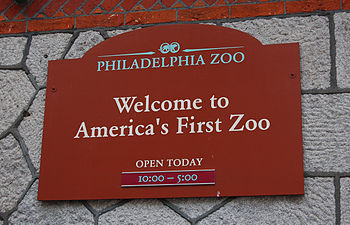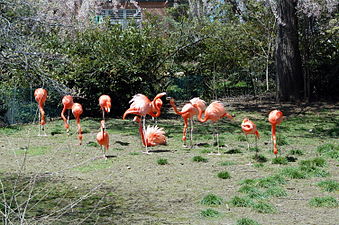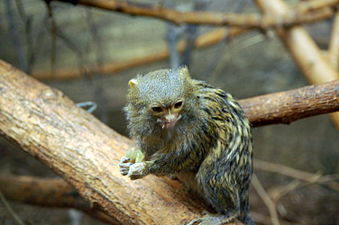Philadelphia Zoo
This article contains promotional content. (February 2017) |
| Philadelphia Zoo | |
|---|---|
 The gate above the zoo's entrance | |
 | |
| 39°58′28.22″N 75°11′44.44″W / 39.9745056°N 75.1956778°W | |
| Slogan | America's First Zoo |
| Date opened | July 1, 1874 |
| Location | Philadelphia, PA, USA |
| Land area | 42 acres (17 ha) |
| No. of animals | ~2,440 |
| No. of species | 340+ |
| Annual visitors | 1.2M |
| Memberships | AZA[1] |
| Owner | The Zoological Society of Philadelphia |
| Public transit access | PHLASH Stops 12 & 14, SEPTA Routes 15 & 38 |
| Website | www |
The Philadelphia Zoo, located in the Centennial District of Philadelphia, Pennsylvania, on the west bank of the Schuylkill River, was the first true zoo in the United States. Chartered by the Commonwealth of Pennsylvania on March 21, 1859, its opening was delayed by the American Civil War until July 1, 1874. It opened with 1,000 animals and an admission price of 25 cents.[2] For a brief time, the zoo also housed animals brought over from safari on behalf of the Smithsonian Institution, which had not yet built the National Zoo.[3]
The Philadelphia Zoo is one of the premier zoos in the world for breeding animals that have been found difficult to breed in captivity.[4] The zoo also works with many groups around the world to protect the natural habitats of the animals in their care.
The zoo is 42 acres (17 ha) and is home to more than 1,300 animals, many of which are rare and endangered. The zoo features a children's zoo, a paddleboat lake, a rainforest themed carousel, and many interactive and educational exhibits.
History

The zoo was once served by the Zoological Garden station on 34th Street and Girard Avenue until 1902.[5]

When the Philadelphia Zoological Garden first opened its Victorian gates on July 1, 1874 to over 3,000 visitors, it was the only institution of its kind in the New World. It began as a full-fledged zoo with varied exhibits: 200 mammals, 67 birds and 15 reptiles. 10-11 acres were enclosed with a cedar picket fence as exhibition space for buffalo, deer, wolves, foxes, bears, monkeys, birds, reptiles, etc. There were goat cart rides. Reptiles and small mammals were housed in The Solitude. There was a Carriage House at the entrance for horses that had transported visitors to the Zoo. Landscaping and architecture created a Victorian garden atmosphere that still is represented on the grounds today. The managers stressed the need for the very best facilities, affording optimum husbandry and in-depth scientific observations, including necropsies.
The 1876 Centennial Exhibition was held in Fairmount Park, a few blocks from the 33-acre Zoo. The U. S. President, Ulysses S. Grant, had officiated at the Exhibition and visited the Zoo on April 23. Zoo attendance that year increased as a result of the Centennial Exhibition: the nearly 680,000 attendance, a 36% increase over the preceding year, set a record that would remain unmatched until 1951, with an attendance of 857,901 visitors.
The Penrose Research Laboratory was established in 1901.[6] The first of its kind in any zoo, contributions of the Penrose Research Lab, have included gains in freedom from disease, increased vigor, longevity and understanding of species across the animal kingdom. In 1901 the lab began performing necropsies on every Zoo animal that became ill and died. The lab's history of preventative medicine reflected the foresight of Dr. Charles B. Penrose and Dr. Cortland Y. White, professors at the Medical School of the University of Pennsylvania.
Over the course of the Zoo's history, the organization has developed a distinguished breeding program and is credited with many "firsts"[7] including: the first successful birth of an orangutan in a U.S. zoo in 1928, the first successful birth of a chimpanzee in a U.S. zoo in 1928, the first cheetahs born in a zoo in 1956, the first successful birth of an echidna in North America in 1983 and first recorded parent-reared Micronesian Kingfisher was bred at Philadelphia Zoo in 1985.
Philadelphia Zoo also pioneered the first captive management of flamingos under the direction of Curator Emeritus John A. Griswold. Through innovative feeding techniques, the Zoo was the first to gain the beautiful pink and red pigmentation of these birds. The Zoo was the first to successfully breed Chilean and greater flamingos in captivity.[8]
The Zoo played an important role in the 1979 film, Rocky II the second installment of the Rocky film franchise.[9] Several romantic scenes were filmed at the Zoo including Rocky Balboa's proposal to Adrian in front of the Carnivore House.
The brown tree snake was introduced to the island of Guam in the 1940s, and as a result, bird species endemic to the island were driven to extinction in the wild by the invasive serpent.[10] In 1983, the Guam Bird Rescue Project was spearheaded by the Philadelphia Zoo in an attempt to save the Micronesian kingfisher and the Guam rail, two native species still present in large enough numbers to benefit from intervention.[11] The rescue plan called for the capture of all kingfishers and rails on Guam and a captive management protocol was formulated. The captive breeding was carried out in U.S. zoos in an effort to save this species from extinction until reintroduction became feasible. In 1985 the first recorded parent-reared Micronesian kingfisher was bred at Philadelphia Zoo.
In the early morning of December 24, 1995, a fire in the World of Primates building killed 23 animals, including a family group of six lowland gorillas, a family group of three orangutans, four white-handed gibbons, and ten lemurs (two ruffed lemurs, six ring-tailed lemurs, and two mongoose lemurs).[12][13] All were members of endangered species. The animals died in their sleep from smoke inhalation (carbon monoxide poisoning); none were burned. Ten primates housed in an adjoining building, the Discovery House, survived. At the time of the fire, detection equipment existed in only 20% of the zoo buildings; the primates building, which had been constructed in 1985, was not one of them. In the ten months following the fire, the zoo installed fire detection equipment in all animal buildings.[14]
On July 1, 1999, the zoo opened a new primate exhibit, the PECO Primate Reserve. It features 2.5 acres (10,000 m2) of indoor and outdoor exhibits with ten species of primates, including Sumatran orangutans, Western lowland gorillas, lemurs, langurs, and gibbons.[15]

In 2006, the zoo opened a new, $20-million big cat exhibit, First Niagara Big Cat Falls. Showcasing the animals in scenes reminiscent of their natural habitats, this exhibit allows visitors to get very close to the cats, sometimes separated only by a pane of glass. Visitors can see 12 endangered big cats from around the world, including three new snow leopard cubs, three new cougar kittens, and a new black jaguar cub.
On May 25, 2007, three Amur tiger cubs were born at the Philadelphia Zoo to mother Kira and father Dmitri (also spelled "Dimitri").[16]
On March 21, 2009, the zoo opened its 150th Anniversary Year-Long Celebrations.

On May 30, 2009, the zoo opened the McNeil Avian Center, a renovation of its classic bird house. It features two birds that are extinct in the wild: the Guam rail and the Guam kingfisher. A theatre presents a fourteen-minute, 4D-movie about avian migration, following the migration of an animated oriole named Otis.
On October 2, 2009, the zoo welcomed a baby Sumatran orangutan, subsequently named "Batu". Batu, a female, is the first-born child to 15-year-old father Sugi and 18-year-old mother Tua. She is also the first baby orangutan to be born in the PECO Primate Reserve, which opened in 1999. The zoo, however, does have a history of successfully breeding orangutans, being the first zoo in the nation to have a successful birth in 1928.
On April 10, 2010, the zoo's seasonal "Creatures of Habitat" opened, a unique exhibit featuring 9 animal stations throughout the zoo, each featuring an endangered animal, and each consisting of statue(s) made completely out of Lego bricks. Each statue was created by Sean Kenney, the first of only nine Lego-certified artists in the world.[17]
On July 17, 2010, the zoo welcomed a new female baby giraffe to first-time parents Stella, 7, and Gus, 4, after a gestation period of over 15 months. This is the first giraffe birth at the Philadelphia Zoo in over a decade.
Philadelphia Zoo opened Treetop Trail in 2011, the first component of its Zoo360 animal exploration trail system, a campus-wide network of see-through mesh trails that allows animals to leave their traditional enclosures and explore more of the campus. Since then, the Great Ape Trail, Big Cat Crossing, and Gorilla Treeway have been added to the system, with additional trails planned for the future.
On April 13, 2013, the zoo opened KidZooU on the site of the old Pachyderm House. Also known as the Hamilton Family Children's Zoo and Faris Family Education Center, it is one of the largest projects undertaken by the zoo and replaces the old Children's Zoo open for over 50 years prior. It is notable for many ecologically conscious features, such as rain gardens and cisterns, geothermal wells, and green roofs, making it the first LEED-certified exhibit at the zoo.[18]
On June 25 and 26, 2014, African lion Tajiri gave birth to four cubs, the first lion cubs born at the zoo since 1996.
On December 29, 2016, Zenda, the oldest African lion in U.S. zoo population, was euthanized, following a sudden loss of appetite and failing health. Zenda was born at the Johannesburg Zoo in South Africa, and came to Philadelphia in 1993. She and her family were part of the Zoo360 trail. Zenda was 25.[19]
Features of the zoo
- Zoo360, a first-of-its-kind animal trail system, consists of four trails—Big Cat Crossing, Gorilla Treeway, Treetop Trail, and Great Ape Trail—with several more planned for the future.
- Outback Outpost Includes emus and a mob of red kangaroos. Formerly housed here were red river hogs and Kesho, an okapi who died in November 2016.
- PECO Primate Reserve was opened in 1999 and features a number of different primate species, including orangutans, gorillas, and gibbons.
- The Rare Animal Conservation Center: Interactive graphics and up-close views of some of the world's most endangered animals: Rodrigues fruit bats, naked mole rats, blue-eyed black lemurs, golden lion tamarins, and more. The Rare Animal Conservation Center is home to Toi, a female red-shanked douc langur, the only one of her species in the United States.
- The Reptile and Amphibian House: Features over 125 species of amphibians and reptiles, including giant tortoises, crocodilians, endangered amphibians like the Panamanian golden frog, and the venomous king cobra.
- Small Mammal House: Features many species of small mammals, such as aardvarks, meerkats, pygmy marmosets, Hoffmann's two-toed sloths, vampire bats, and many more. A recent addition was an outdoor trail system called Meerkat Maze, which allows the meerkats to tunnel alongside guests.
- Hamilton Family KidZooU & Farris Family Education Center: Formerly the Pachyderm House, this children's zoo is divided between indoor and outdoor exhibits and is open all year. Outdoor exhibits put the emphasis on rare breeds, including Arapawa goat, Jacob sheep, miniature horses, homing pigeons, chickens, and ducks. There is an opportunity for animal petting in the contact yard, as well as duck feedings and shows highlighting animal training. Indoor exhibits put an emphasis on energy conservation and animal empathy through games, parallel play, and live animal exhibits. Animals found here include butterflies, reef fish, Panamanian golden frogs, budgies, ants, fancy rats, and a chick hatchery. Found throughout KidZooU are areas appropriate for very young children and quiet spaces.
- McNeil Avian Center: An aviary finished in 2009 featuring many species of birds, mainly from Africa, the Pacific Islands, and South America. Some species include the extinct-in-the-wild Guam kingfisher and Guam rail and critically endangered Bali mynahs. Other birds include rhinoceros hornbills, Mariana fruit doves, Victoria crowned pigeons, and many others. There is also a 4-D Migration Theater telling the story of an Baltimore oriole named Otis and his migration.
- Bird Valley: A section near the McNeil Avian Center featuring an artificial creek running down a small hill. It is home to waterfowl, Humboldt penguins, American flamingos, and turkey vultures.
- Keybank Big Cat Falls: Features numerous species of wild cats including African lions, Siberian tigers, Amur leopards, snow leopards, jaguars, and pumas. It was in this area of the zoo that Rocky Balboa proposed to Adrian in Rocky II, although that original site, the Carnivora House, has been revamped and renovated into its current Big Cat Falls.
- Carnivore Kingdom: Features a family of rare, playful giant otters, southern ground hornbills, red pandas, black-footed cats, white-nosed coatis, and Canada lynx in unique naturalistic environments. The only breeding giant otters in North America. The zoo was also the first to exhibit them in 1996 and the first and only to breed them in 2004.
- African Plains: Features a white rhinoceros, Dama gazelles, red river hogs, reticulated giraffes, Chapman's zebras, and hippos.
- Completed in 1980, Bear Country replaced the zoo's historic bear pits originally constructed in 1874. Bear Country currently features four bear species: sloth bears, an Asiatic black bear, an Andean bear, and a rare polar bear.
- Impala Lawn Includes a multi-use space and stage sponsored by Fisher-Price, often used for children's music programs.
- Educational programs are offered for children. Thousands of school children from the Philadelphia Metropolitan area visit each year. Overnights for scouts, families, and youth groups are also offered. The Zoo also offers special behind-the-scenes experiences.
- The Animal Health Center: The Philadelphia Zoo hosts one of the nation's busiest and most comprehensive animal hospital and health-care facilities.
- Peafowl walk around the zoo freely.
- Concert Series: The Philadelphia Zoo started hosting concerts in the summer of 2014. The first band to play on the concert stage was local country band Southern Tyde, who opened for headliner Brett Eldredge.
- Seasonal Events: The Zoo hosts many events throughout the year, including the Summer Ale Festival and the Annual Conservation Gala.
Gallery
-
The zoo's welcome sign
-
A flock of flamingos
-
A cheetah in his enclosure
-
A pygmy marmoset at the Small Mammals exhibit
-
Polar bear inside her enclosure
See also
Notes
- ^ "Currently Accredited Zoos and Aquariums". aza.org. AZA. Retrieved July 7, 2012.
- ^ Ashbrook Apartments newsletter, July 2009, Carrboro, North Carolina
- ^ "National Zoological Park, Records". Record Unit 74. Smithsonian Institution Archives. Retrieved 10 April 2012.
- ^ Philadelphia Tours & Attractions
- ^ "Officials working to restore rail passenger service to Philly Zoo".
- ^ Federal Writer' Project (Pa.) (September 9, 2010). Philadelphia, A Guide to the Nation's Birthplace. Nabu Press. p. 740. ISBN 978-1171867654.
- ^ "Philadelphia Zoo Media Kit".
- ^ Johnson, Alan; Cezilly, Frank (January 1, 2009). The Greater Flamingo. p. 193. ISBN 9781408108970.
- ^ "Rocky II Filming Locations". IMDb.
- ^ "Invasive Species: Animals - Brown Tree Snake". invasivespeciesinfo.gov. United States Department of Agriculture.
- ^ "Guam Kingfisher". Philadelphia Zoo. Philadelphia Zoo.
- ^ Philadelphia Zoo Fire
- ^ "Fire at the Philadelphia Zoo Kills 23 Primates". New York Times. Associated Press. December 25, 1995. Retrieved February 22, 2017.
- ^ "From the Ashes" (PDF). AZA. Retrieved 2007-05-26.
- ^ Gorilla antics anew at Philadelphia's zoo
- ^ "Kira and Cubs". Philadelphia Zoo. Archived from the original on 2007-12-19. Retrieved 2007-05-26.
- ^ Zoo Unveils Exclusive Creatures Of Habitat Lego Brick Animal Exhibit
- ^ The KidZooU is the Philadelphia Zoo’s first LEED – certified exhibit. http://kidzoou.org/Earth-Friendly-KidZooU.aspx
- ^ "Philadelphia's Zenda, oldest lion in the U.S., dies at 25". Philly.com. December 30, 2016. Retrieved January 3, 2016.
References
- Dewan, Vikram. Best for the animals, best for the zoo, Philadelphia Daily News, December 4, 2006, retrieved December 4, 2006.








